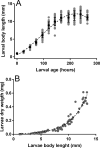Rearing methods and life cycle characteristics of Chironomus sp. Florida (Chironomidae: Diptera): A rapid-developing species for laboratory studies
- PMID: 33617595
- PMCID: PMC7899323
- DOI: 10.1371/journal.pone.0247382
Rearing methods and life cycle characteristics of Chironomus sp. Florida (Chironomidae: Diptera): A rapid-developing species for laboratory studies
Erratum in
-
Correction: Rearing methods and life cycle characteristics of Chironomus sp. Florida (Chironomidae: Diptera): A rapid-developing species for laboratory studies.PLoS One. 2025 Apr 1;20(4):e0321565. doi: 10.1371/journal.pone.0321565. eCollection 2025. PLoS One. 2025. PMID: 40168293 Free PMC article.
Abstract
The species Chironomus sp. "Florida" has several qualities that make it a potential aquatic laboratory model to be used in Puerto Rico. Its use as such, however, requires a rearing protocol and life cycle description not previously reported. The present study addresses this lack of information by first describing a rearing method obtained through three years of observations. Next we describe and discuss the life cycle and the effects of temperature and feeding on development. The species has a short life cycle (typically 11 days) and larval stages easily identified using body measurements. Temperature affects the duration of the life cycle, with warm temperatures producing faster development than cold temperatures. The effects of different food concentrations vary: in large water volumes, concentrations of 2 mg/larva/day produce faster developmental times, but at low water volumes, small food concentrations of 0.5 mg/larva/day produce faster developmental times. The rearing protocol and life cycle parameters presented in this study are intended to promote the use of this species as a laboratory model. The fast development of Chironomus sp. "Florida" makes it ideal for toxicological studies.
Conflict of interest statement
The authors have declared that no competing interests exist.
Figures





References
-
- Pinder LC V. The habitats of chironomid larvae In: Armitage PD, editor. The Chironomidae: biology and ecology of non-biting midges. Springer; 1995. pp. 107–135.
-
- Berg MB. Larval food and feeding behaviour In: Armitage PD, editor. The Chironomidae: biology and ecology of non-biting midges. Springer; 1995. pp. 136–168.
-
- Osmulski PA, Leyko W. Structure, function and physiological role of Chironomus haemoglobin. Comp Biochem Physiol—Part B Biochem. 1986;85: 701–722. 10.1016/0305-0491(86)90166-5 - DOI
Publication types
MeSH terms
Grants and funding
LinkOut - more resources
Full Text Sources
Other Literature Sources

